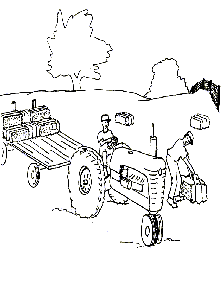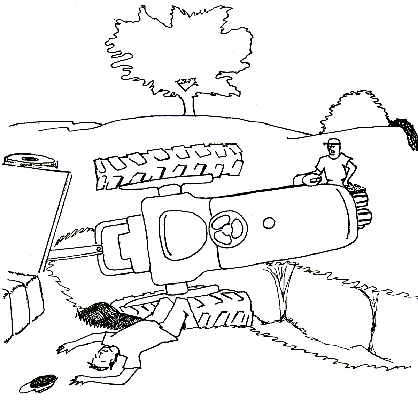Spinal Cord Injury - Narrative Simulation
What Happened To Bob?

Purpose
This simulation exercise is a story about two teenagers
who are cousins. The exercise is based on discussions with
parents and their children across Kentucky, Iowa, and Mississippi.
The exercise also includes information from University of
Kentucky researchers about economics, productivity, health,
and injury. The purpose of the exercise is to tell the story
of Bob and Henry in a way that lets you experience some
of the decisions the characters face as they experience,
and then cope with, a serious farm injury. We hope the exercise
is meaningful for you and will help you develop safe farm
work practices.
Credits
This simulation exercise was initially developed in 1999
by Pamela Kidd, Deborah Reed, Henry Cole, Daniel Rosnik
and Tim Struttmann at the Southeast Center for Agricultural
Health and Injury Prevention, the Kentucky Injury Prevention
and Research Center, and the University of Kentucky College
of Nursing under the United States Department of Health
& Human Services/United States Public Health Service/Centers
for Disease Control & Prevention/ National Institute
for Occupational Safety and Health (NIOSH) Grant #1 RO1
CCR414307 to the Southeast Center for Agricultural Health
and Injury Prevention, Deborah Reed, Principal Investigator.
The views and conclusions contained in the document are
those of the authors and do not necessarily represent the
official policies or recommendations of NIOSH, the University
of Kentucky or any department or agency of the government
of the United States or the Commonwealth of Kentucky.
Instructions
You should have three items to complete this simulation: A problem book, an answer sheet, and a pencil. Read the background information and problem situation described on the following pages. Next, answer each of the questions one at a time. Do not mark your answers in the problem book. When you have selected an answer to a question, look up its number on the answer sheet, and circle T if the answer is true or F if it is false. Some questions may have more than one true answer. Don't jump ahead. As you work the exercise, look at the background information about "What Happened to Bob?" as often as you need to. It's okay to look back to earlier questions and answers, but please don't change your answers.
When you have finished, you will learn how to score your answers. You will also receive a master answer sheet that will explain why each answer is true or false.
Background Information
Bob and Henry
Bob and Henry are cousins. It is summer and Henry is visiting Bob's family. Bob lives on a farm and has worked with his dad and driven tractors since he was eight years old. Now Bob is 14. Henry lives in the city. He looks forward to coming to Bob's house each summer for a long visit when school is out. Now that Henry is 14, Bob's dad is paying him to work on the farm.
Problem
It
is a beautiful summer day. The last chore for the boys is
to pick up the few remaining square hay bales. They want
to complete this task in time to go over to a friend's house.
They plan to ride into town with their friend to see a movie.

Which of the following could have prevented this injury?
1. A Roll Over Protective Structure (ROPS) on the tractor and the operator wearing a fastened seatbelt
2.
Using a newer tractor
3. Using a tractor with more horsepower
4. Having Henry drive the tractor
5. Bob paying attention and watching where he was going
Some hours later, Bob is in a trauma hospital, where he
was taken by helicopter. His parents are at his bedside
when the doctor comes in and tells them that Bob will be
paralyzed from the waist down for the rest of his life.
Now he must use a wheelchair.
Question B
Which of the following statements about Bob are true for the
rest of his life?
6. He will be unable to walk without assistive devices
7. He will not have normal control of his bowels and bladder
8. He will have difficulty making love
9. He will be at risk for deep and festering skin sores
10. As he gets older the paralysis will spread to the rest
of his body

This curriculum guide was supported by Grant Number 1 R01/CCR414307 from NIOSH. Its contents are solely the responsibility of the authors and do not necessarily represent the official views of NIOSH. Special thanks to Dr. Ted Scharf.
Disclaimer and Reproduction Information: Information in NASD does not represent NIOSH policy. Information included in NASD appears by permission of the author and/or copyright holder. More